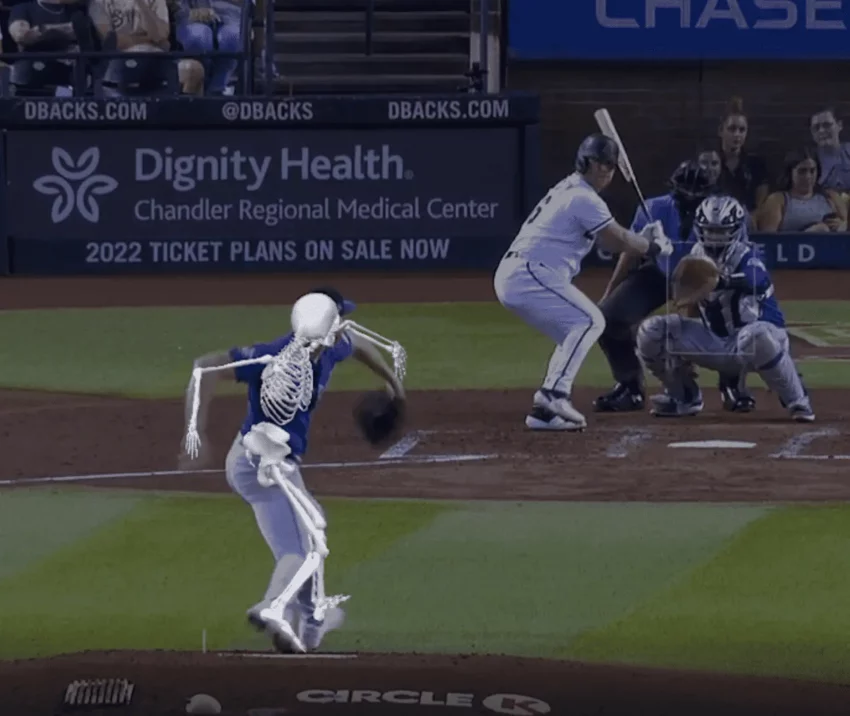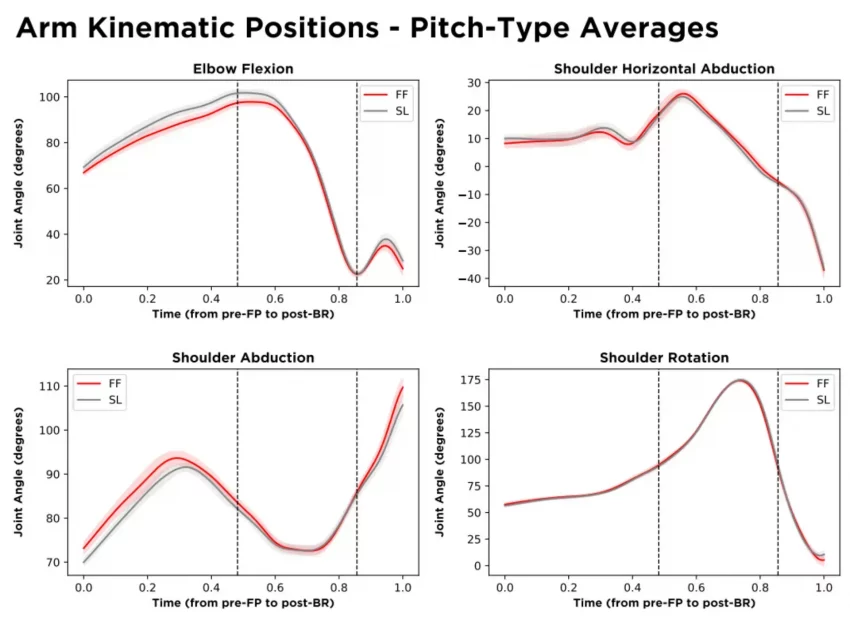Breaking New Ground: How Major League Teams Are Leveraging In-Game Biomechanics Data

Biomechanics used to be hard. Well, it’s still hard, but it used to be harder.
In order to collect traditional marker-based motion capture data–like the kind we’ve done at Driveline–there are a host of hoops to jump through. You need skilled technicians who know how to apply markers to the athletes. You need to have the athletes strip down to just their compression shorts for the session. You have to clean and process the data. You’re limited to only collecting biomechanics data in a controlled environment. In many cases you have to spend six figures on the equipment alone. Overall it’s an invasive and time-consuming process.
With the advent of markerless biomechanics technologies like Hawk-Eye and KinaTrax, a lot of those issues are a thing of the past. Now you just have to click the record button and boom – biomechanics data.
Today, biomechanics labs are commonplace in training facilities. MLB teams are building fully swagged out biomechanics labs left and right. Every week it seems like there’s a new company that can capture biomechanics data.
We’re a long way away from the early 2000s when basically only ASMI was doing anything with biomechanics in baseball.
Markerless biomechanics also allows something especially valuable–the ability to capture in-game biomechanics data. No more markers means we can get biomechanics data on athletes in competition environments. Every game, every pitch.
Data collection has gotten easier by orders of magnitude, but one element still remains incredibly difficult: interpreting the data.
Biomechanics data is inherently complicated. The biomechanics vernacular isn’t super approachable to your everyday coach. What even is “shoulder horizontal abduction” or “trunk lateral tilt”? Describing how a player moves in biomechanical terms just isn’t easy.
So besides making some sweet visualizations, what can you actually do with that in-game biomechanics data?
Monitoring Mechanics
The first thing you can do with in-game biomechanics data is to monitor how a player is moving over time. How are their mechanics changing from game-to-game, outing-to-outing?
Adam Wainwright had a great tweet-thread on how his mechanics changed towards the end of the season and how those changes affected his performance. Namely, he unknowingly shortened his stride length which caused a host of other issues in his delivery.
With in-game biomechanics data, you have the ability to quantitatively monitor these trends on a day-to-day basis. No more eyeballing video side-by-side. You have hard data immediately after the game on how a player’s mechanics are trending, and if something needs to be done about it..


Another example: what if a pitcher was throwing harder and absolutely shoving earlier in the year, but now his velo has dropped and he’s struggling?
By comparing his last outing to previous outings when he was dialed in, you can quickly identify whether his mechanics have changed. What if his arm action has changed? What if he’s just not moving as fast? What if he’s changed the way he loads on his back leg?
Take the two graphs below, for example. Can you tell how this pitcher changed the way he loaded his backside in his last outing when his velocity was down? He exhibited decreased lateral pelvis tilt (left graph; yellow line) and decreased back hip flexion (right graph; green line) during his stride down the mound, both symptomatic of reduced back-side loading.

Last outing in yellow, a previous outing when he sat 95+ mph in gray
These are just a couple of examples, but there are countless other situations where you can leverage in-game biomechanics data to monitor mechanics over time. How are a pitcher’s mechanics progressing as he returns from rehab? Can we automatically flag any potentially detrimental mechanical changes as the season wears on?
The best teams are already doing exactly this – identifying potentially negative mechanical changes and addressing them immediately, rather than letting them linger and potentially cause larger problems.
Pitch Tipping
You can also use in-game biomechanics data to detect if a pitcher is pitching his tips tipping his pitches.
Cameron Grove put out an awesome tweet thread on Luis Castillo examining if he was tipping his sinker by changing the timing of his delivery.
Or what if a pitcher changes his set position he’s going to throw an off speed pitch? Mike Trout picked up on this when Elvis Peguero was doing just that.
It shouldn’t be up to your center fielder to notice this – the technology exists to automatically detect it! By looking at various biomechanical parameters across different pitch types you can sniff out when a pitcher is potentially tipping his pitches.

Notice how this pitcher’s elbow flexion and shoulder abduction are noticeably different early in the delivery when throwing a fastball vs. a slider
Player Development
You can also use biomechanics data to drive player development decisions. It’s what Driveline has been doing for years.
By getting a snapshot of a player’s mechanics, you can drive their improvement. What areas of the delivery do they lack in compared to the guys who throw 95? Maybe their lead leg block could be better. Maybe their arm action could use some improvement.
Where it gets complicated is what you actually do about those things. Maybe there’s a drill you think will drive those positive mechanical improvements for an athlete. Maybe they need to get stronger. Maybe their physiology prevents them from getting into certain positions. At Driveline, we have a set of metrics that we’ve found correlate strongest to pitching velocity and swing velocity, which we then use to prescribe drills and exercises. We pair that with our strength and physical therapy assessments to plot the best path forward for each athlete.

After a training block we reassess to see how the athlete’s mechanics have improved, and most importantly, if their performance improved. Then we pick out the next mechanical deficiency to focus on. Rinse and repeat. As the player’s performance improves, i.e. they’re throwing or hitting the ball harder, we learn more and more about the player’s ideal mechanics.
Initial assessment in red, retest in green
Markerless motion capture not only drives these insights, it enables them to be captured more frequently, and in the actual competitive environment. You no longer need to sacrifice training time to perform in a lab setting to get retest data. Markerless tech puts the biomechanics test-retest loop in the background, where it should be.
But in professional baseball, you don’t just get the athletes you get. You get to pick the players in your organization. This leads us to another use-case for in-game biomechanics data…
Scouting
Teams scout for players based on their TrackMan data all the time, so why can’t they use biomechanics data too?
An example: you find a pitcher who scores low in the biomechanics evaluation has also had poor performance on the field. In his biomechanics data you see that he doesn’t have a great arm action — and you’re confident that that’s something you can clean up. Maybe that pitcher then picks up a couple of extra ticks on his fastball. You just turned that previously under-valued player into a potential prospect.
Poor biomechanical scores and poor performance present an opportunity for clear improvement.
Or what if you’re looking to make a splash in the off-season and sign a big ticket free agent. You can check that not only does that player have good performance on the field, but he scores high in the biomechanics assessment.
High performance and high biomechanical scores means you can sign a large-ticket free agent with confidence.
One way to visualize this is to bucket all of the metrics into what areas of the body they correspond to, and compare the player against the rest of the league. How does his arm action stack up against the best of the best? How about his lower half? How fast does he move?

These situations can be extrapolated out to any number of scenarios — potential trade targets, draft targets, and so on.
It’s another tool in the toolkit to find undervalued talent.
Wrapping It Up
Ethan Moore wrote a great article about The Future of the MLB R&D Department, which you should definitely go read. While his post focuses on the bigger picture of how an R&D department can have greater upside, he does list some initiatives that teams can target in order to see better returns. One of which is to evaluate new data.
Biomechanics data isn’t entirely new, but the ability to collect it in-game, at scale, is new. The teams that can not only leverage these insights but effectively translate them to coaches and players will have a big leg up on the competition.
What if Adam Wainwright was able to find his mechanical flaw after the first start it appeared and was able to immediately fix it in his next start?
How many otherwise lackluster prospects have clear mechanical deficiencies that can be cleaned up and turned into future big leaguers?
The same way that bat and ball tracking technology revolutionized the way that teams scout and develop players, so too will biomechanics data. With the proliferation of in-game biomechanics technologies, the era of biomechanics isn’t coming – it’s already here.
—
If you or your organization need help handling biomechanics data, check out our Biomechanics Services page, or email [email protected] for more information!
Written by Joe Marsh – Director of Engineering
Comment section